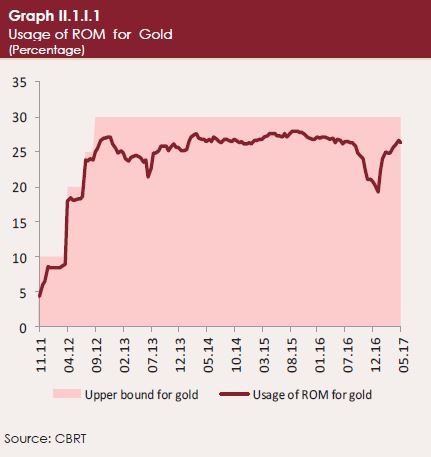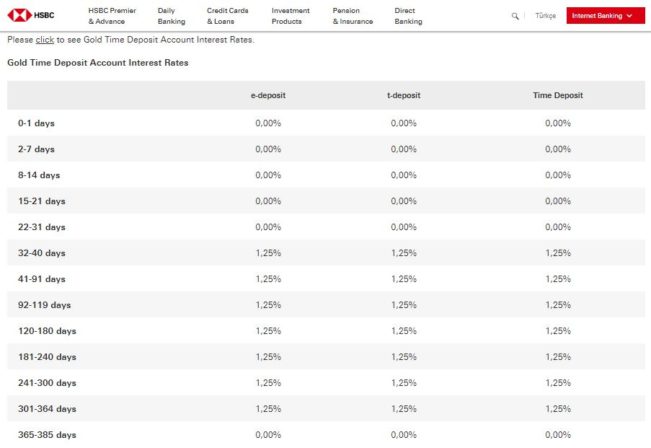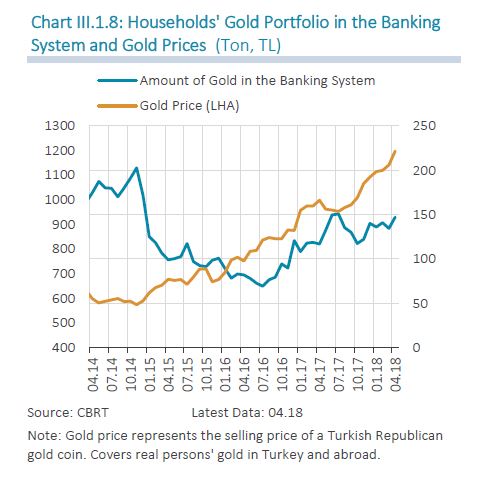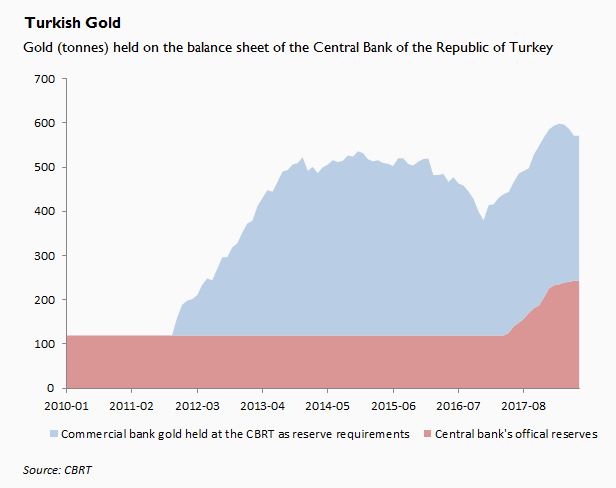Turkey’s Attempt to Mop Up Mattress Gold
This blog post is a guest post on BullionStar’s Blog by the renowned blogger JP Koning who will be writing about monetary economics, central banking and gold. BullionStar does not endorse or oppose the opinions presented but encourage a healthy debate.
The Turkish government, in particular its central bank, has a relatively unique relationship to gold. Few governments directly involve themselves in the gold market as much as Turkey’s. This post provides a short review of this relationship.
Gold is popular in Turkey. According to a 2015 report by the World Gold Council, Turkey generally accounts for around 6% of global gold consumer demand. It is further estimated that there are around 3,500 tons of under-the-mattress gold in Turkey, which makes Turkey one of the largest gold sinks in the world. The existence of this “mattress gold" is believed to inhibit the growth of bank intermediation. By encouraging Turks to bring their gold to banks to be deposited, Turkish authorities believe that overall engagement with banks will increase, presumably leading to faster economic growth. Notably, India has also been very aggressive in trying to bring “idle" gold into the banking system, having launched a gold monetization scheme in 2015.
Required reserves in the form of gold
The nation’s central bank, the Central Bank of the Republic of Turkey (CBRT), has become particularly active in the campaign to draw gold into the banking system. It does so by allowing central banks to keep some portion of their required reserves in the form of gold. Let’s unpack the idea of reserve requirements a bit more. Central banks often (though not always) require deposit-taking commercial banks to permanently freeze a fixed amount of reserves at the central bank. (Canada for instance has no reserve requirements). A central bank that imposes reserve requirements typically remunerates reserves at a below-market rate, sometimes 0%. Required reserves therefore function as a tax on the banking system. If banks weren’t required to keep funds in their central bank accounts, they would be investing the funds elsewhere at a higher rate.
Turkish banks were cut some slack in 2011 when the CBRT implemented a special program called the Reserve Option Mechanism, or ROM. Instead of requiring that banks meet their entire reserve requirement by holding poorly-compensated Turkish lira funds at the CBRT, the Reserve Option Mechanism allowed them to satisfy up to 30% of their requirements by depositing gold at the central bank. This offer was quickly taken up by Turkish banks, who began to deposit gold up to the maximum allowed amount. The chart below illustrates the popularity of the ROM. The 30% tranche, which was introduced in stages starting with a 10% tranche in 2011 and subsequently boosted to 20% and then 25% in 2012, has almost always been used to its full capacity.

Given Turkish banks’ eagerness to deposit gold, it is fair to say that the Reserve Option Mechanism offered banks a cheaper alternative for meeting reserve requirements than the traditional avenue of borrowing Turkish lira funds and keeping them on deposit at the CBRT. Put differently, the gold option has provided bankers with a route for reducing the size of the tax imposed on the banking sector by reserve requirements.
Gold deposit accounts
To help attract the necessary gold, Turkish banks began to offer the public the option of opening gold deposit accounts. These accounts can either be current deposit accounts, which can be withdrawn at anytime, or time deposit accounts, which are locked in for a period of time. Time deposits are remunerated. HSBC Turkey, for instance, currently pays gold depositors 1.25% for a one-year fixed deposit, as illustrated below. In effect, the tax break that the CBRT provides banks via the Reserve Option Mechanism is being shared with the Turkish public in the form of interest.

The gold is held in unallocated form rather than in allocated form. When a customer deposits physical gold with their bank, the bank in turn takes its customers’ grams and pushes them at the CBRT to meet a portion of its reserve requirements. A customer can also deposit Turkish lira to open a gold account. In this case, the bank can use those funds to purchase gold in order to meet its reserve requirements. In general, banks do not seem to allow customers to withdraw their gold in physical form. ISbank is an exception, but only allows conversion of gold deposits in amounts greater than five kilograms. Turkish banks have other options for securing gold including borrowing or swapping for gold in the institutional gold market.
By mid-2013, CBRT data shows that around US$12 billion worth of gold deposit accounts had been opened by banks, representing around 200 tons of gold. But gold deposits wilted through 2015 and 2016, eventually falling to around 75 tons worth. As of April 2018, around 150 tons worth of gold deposits are outstanding, as illustrated by the blue line in the chart below.

Keep in mind that only a fraction of this 150 ton deposit base would have been opened with actual mattress gold, the majority probably being purchased by depositing Turkish lira. So although the ROM has been almost fully utilized and has encouraged the growth of gold deposit accounts, most of Turkey’s 3,500 or so tonnes in mattress gold remains outside of the banking system.
Gold on the CBRT’s balance sheet – What does it actually own?
Gold is currently accounted for on the CBRT’s balance sheet at 571.5 million grams, or 571 tonnes, putting it twelfth on the list of countries sorted by size of gold reserves. But one needs to be careful with this amount. Most of the gold on the CBRT’s balance sheet is not the property of the bank, but rather is held on behalf of commercial banks that happen to be using the ROM facility. This amount needs to be subtracted from the central bank’s total holdings to arrive at the total quantity of gold that officially belongs to the Turkish state.
The chart below decomposes the quantity of gold on the CBRT’s balance sheet into two categories: 1) gold being held on behalf of banks to satisfy reserve requirements (blue area), and; 2) gold held as an official reserve asset (pink area). With the ROM being introduced in early 2011, banks went from holding 0 tonnes at the CBRT to holding as much as 417 tons by late 2014, after which ROM usage fluctuated to as low as 260 tonnes before rebuilding to today’s 327 tonnes. Meanwhile, the amount of gold that the CBRT actually owns clocked in at a constant 119 tonnes from 2011 to 2017. This means that (until mid-2017) all of the changes in the gold portion of the CBRT’s balance sheet has been due to varying commercial bank usage of the Reserve Option Mechanism, not official changes in Turkey gold ownership.

Things changed in mid-2017 when Turkey finally began to buy gold on an official basis. Since then, gold holdings have more than doubled from 119 tonnes to 244 tonnes. This reportedly comes at the behest of PM Erdoğan, who seemingly has a soft spot for the yellow metal. (Ronan Manly has written an article showing how the location of those reserves has been changing.)
As for the Reserve Option Mechanism, it was further expanded in 2016 when the CBRT allowed banks to keep an additional 5% of required reserves in the form of wrought or scrap gold. The already-existing 30% ROM tranche, introduced in 2011, had only allowed for the usage of standard gold — gold bars in a range of weights of minimum 995/1000 fineness as defined by the Borsa Istanbul. By allowing for scrap gold – unprocessed gold below 995/1000 fineness – to be used to satisfy reserve requirements, the CBRT was hoping to draw additional gold savings out from under people’s mattresses and into the banking system. The scrap gold mechanism has not been very popular. According to the CBRT’s 2017 annual report, at the end of 2017, only 17% of the head-room provided by the option was being utilized.
In an attempt to attract even more gold into the banking system, Turkish authorities began to issue gold bonds and gold-backed lease certificates to the public in 2017. The one-year interest rate on these bonds was 2.4%. The first round, which ran from October 2-27, 2017, attracted just 2.5 tons, while the second round, which ran from March 26 to April 20, 2018 period, brought in 1.9 tons. I’ve sourced these numbers from the CBRT’s May 2018 Financial Stability Report. Given the small amounts of gold that have been collected by bonds and lease certificates, these efforts can only be considered a failure.
Conclusion
Turkey’s campaign to mop up mattress gold hasn’t been very successful. Neither the original 2011 Reserve Option Mechanism nor its 2016 extension to scrap metal have attracted large amounts of physical gold from the public. The recent attempts at pushing gold bonds and lease certificates on the public have also fallen flat.
Presumably the Turkish government will have to increase its efforts if it wants to put a real dent in the 3,500 tonnes of mattress gold presumed to be held by Turks. This may require a much larger ROM gold tranche or higher interest rates on gold bonds. As it is, the 2.4% paid on gold bonds simply hasn’t enticed the public into giving up their gold. But using more resources to attract gold out from mattresses will only come at the expense of Turkish taxpayers. Is it worth it? If the effort to mop up Turkey’s mattress gold does expand, at some point the presumed benefits of capturing mattress gold will be overwhelmed by the costs of overcoming people’s fondness for the yellow metal.
Popular Blog Posts by JP Koning
 How Mints Will Be Affected by Surging Bullion Coin Demand
How Mints Will Be Affected by Surging Bullion Coin Demand
 Banknotes and Coronavirus
Banknotes and Coronavirus
 Gold Confiscation – Can It Happen Again?
Gold Confiscation – Can It Happen Again?
 Eight Centuries of Interest Rates
Eight Centuries of Interest Rates
 The Shrinking Window For Anonymous Exchange
The Shrinking Window For Anonymous Exchange
 A New Era of Digital Gold Payment Systems?
A New Era of Digital Gold Payment Systems?
 Life Under a Gold Standard
Life Under a Gold Standard
 Why Are Gold & Bonds Rising Together?
Why Are Gold & Bonds Rising Together?
 Does Anyone Use the IMF’s SDR?
Does Anyone Use the IMF’s SDR?
 HyperBitcoinization
HyperBitcoinization






 JP Koning
JP Koning 2 Comments
2 Comments










